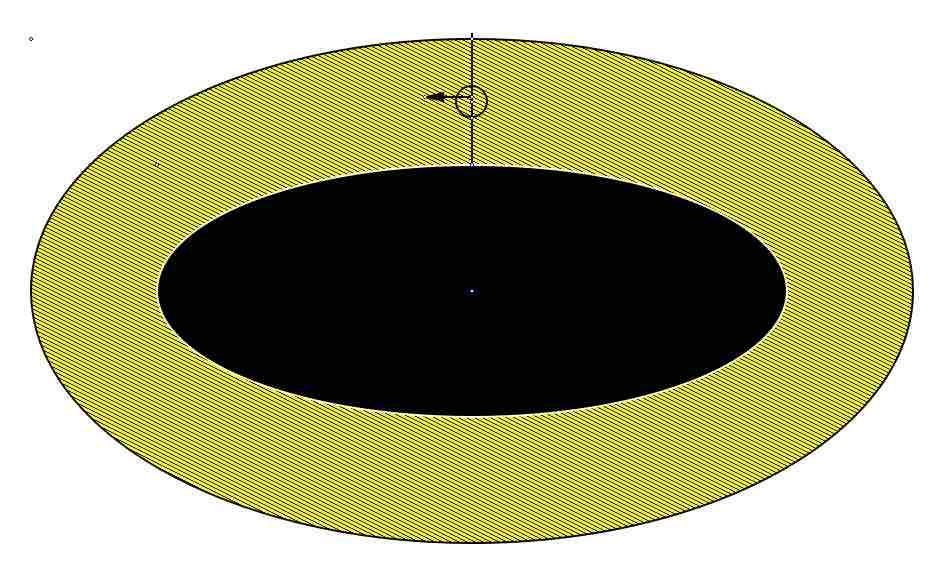| Submit | All submissions | Best solutions | Back to list |
HS11SPDW - Speedway |
Given a vehicle and an oval circuit surface you are requested to compute a route around the track for a vehicle, making it as fast as possible.
The track is bounded by two ellipses: the outer one and the inner one. You must keep the vehicle inside the outer ellipse and outside the inner ellipse. The centers of both ellipses are placed in the same point (0, 0). The lengths of the semi-axes are:
- hIW - the length of the semi-axis parallel to the x-axis of the inner ellipse
- hIH - the length of the semi-axis parallel to the y-axis of the inner ellipse
- hOW - the length of the semi-axis parallel to the x-axis of the outer ellipse
- hOH - the length of the semi-axis parallel to the y-axis of the outer ellipse
Your vehicle is very simple and at every moment it is able to perform only one action among the two:
- to turn_left - the vehicle turns left by the angle a and slows down (decelerates).
- to speed_up - the vehicle accelerates keeping the previous direction.
Acceleration and deceleration rates are parameters of the vehicle: acc, dec.

Simulation
The simulation proceeds in steps. At the beginning (step 0) the vehicle is placed at point (0, (hIH + hOH)/2) with initial velocity = [-1, 0]. The coordinates and velocity of your vehicle in the next steps depend on the previous coordinates, its velocity, and the command it is following.
The vehicle coordinates in the (n+1)-th step are simply coordinates in the n-th step plus velocity (where velocity is a vector, thus addition is performed separately for the horizontal and vertical coordinates).
If the n-th action is speed_up, than the vehicle's velocity in the (n+1)-th step is: (|velocity| + acc) / |velocity|) velocity.
If the n-th action is turn, than the vehicle's velocity in the (n+1)-th step is: (|velocity| - dec) / |velocity|) velocity R, where R is the two-dimensional rotation matrix by adegrees.
You control your vehicle by two commands: s for speed_up and t for turn_left. We will assume that the vehicle never stops and if you command it to stop (or something close to stop, that is you give the command t while the vehicle's speed is at most dec+0.0001), the vehicle will accelerate anyway.
Simulate the process using the single-precision floating-point variables (e.g. float in C, C++, Java, ...).
Input
The first line contains the number of test cases t. Each of the following t lines contains: 4 integers 10 < hIW, hIH, hOW, hOH < 1000, hIW<hOW and hIH<hOH (describing the arena), and 3 positive numbers acc, dec, a describing the vehicle.
Output
For each test case output the number k of steps which could have led from the initial vehicle position to the completion of one lap of the track and in the next line, the description of those steps (please consult the example below) or one word NO if you do not want to solve this particular test case.
Scoring
The score awarded to your program for a given test case is computed as 1000-k.
The score awarded for a given test set is computed as a maximum of 0 and the sum of scores for individual test cases. The overall score of the program is the sum of scores obtained for correctly solved tests.
The number of points given in the ranking is scaled so that it is equal to 10 for the registered contestant whose solution has the highest score, and proportionally less for all solutions with lower scores.
Example
Input: 2 300 150 450 300 0.3 0.7 15.0 300 150 320 170 0.3 0.3 5.0 Output: 142 sssssssssssssssssssssssstsssssstsssssstssssstsssssssstsst ssstsstssststssssstsssstssssssssssssssssstssssststsstssts tststsssstsststssssstsssssss [the whole string in one line] NO Scoring: test1 1000-142=858 points test2 skipped set score: 858 points.
The trace for the above route is available here.
Input data
n t k l 1 1 >40 2s 2 6 >70 2s 3 10 >100 2s 4 10 >350 2s 5 10 ?? 5s 6 10 ?? 5s 7 10 ?? 5s (some cases might be unsolvable) n - test set number t - the amount of test cases in the test set k - the expected number of steps to be taken l - time limit
Please note
- Till the last week of the series, all submitted codes will be visible to all users and tested on temporary data sets only.
- For the last week of the series, submissions will be visible to the submitting contestant, only, and tested on the full set of test cases.
- After the deadline datasets will be slightly modified and all solutions will be rejudged.
- Please do not submit more than 100 times to this problem (all submissions starting with the 101st will be ignored).
| Added by: | kuszi |
| Date: | 2012-01-26 |
| Time limit: | 0.400s-1s |
| Source limit: | 50000B |
| Memory limit: | 1536MB |
| Cluster: | Cube (Intel G860) |
| Languages: | ADA95 ASM32 ASM64 BASH BF C CSHARP C++ 4.3.2 CPP C99 CLPS CLOJURE LISP sbcl LISP clisp D ERL FSHARP FORTRAN GO HASK ICON JAVA JS-RHINO LUA NEM NICE OCAML PAS-GPC PAS-FPC PERL PERL6 PHP PIKE PRLG-swi PYTHON PYTHON3 RUBY SCALA SCM guile SCM qobi ST TCL WHITESPACE |
| Resource: | High School Programming League |

 RSS
RSS